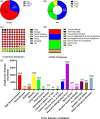The effects of comorbidities on the change of taste and smell in COVID-19 patients
- PMID: 36846410
- PMCID: PMC9948579
- DOI: 10.1002/lio2.1012
The effects of comorbidities on the change of taste and smell in COVID-19 patients
Abstract
Background: Sudden chemosensory changes were considered an early predictor of COVID-19. Here, the effects of comorbidities on changes in taste and smell in COVID-19 patients were investigated based on a worldwide study.
Methods: Data analyzed here were collected from the Global Consortium for Chemosensory Research (GCCR) core questionnaire, including questions regarding preexisting disease conditions. Overall, the final sample of 12,438 participants who were diagnosed with COVID-19 included patients with preexisting conditions. Mixed linear regression models were used to test our hypothesis, and the p-value of interaction was examined.
Results: A total of 61,067 participants completed the GCCR questionnaire, including 16,016 participants had preexisting diseases. The multivariate regression analysis showed that individuals with high blood pressure, lung disease, or sinus problems, or neurological diseases exhibited worse self-reported smell loss (p < .05), but no apparent significant differences in the smell or taste recovery. COVID-19 patients with seasonal allergy/hay fever lost their olfactory ability more than patients who did not have it (with 11.90 [9.67, 14.13] vs. without 6.97 [6.04, 7.91], p < .0001). The taste ability, smell loss and taste loss after COVID-19 recovery also decreased in the COVID-19 patients with seasonal allergy/hay fever (p < .001). Preexisting condition of diabetes did not worsen to chemosensory disorder but also had no obvious impact on the chemosensory recovery after acute infection. Preexisting diseases also affected the type of smell change in the COVID-19 patients with seasonal allergy/hay fever or sinus problems (p < .05).
Conclusions: COVID-19 patients with high blood pressure, lung disease, or sinus problems, or neurological diseases exhibited worse self-reported smell loss, but no differences in the smell or taste recovery. COVID-19 patients with seasonal allergy/hay fever had greater loss of smell and taste, poorer smell and taste recovery.
Level of evidence: 4.
Keywords: COVID‐19; comorbidity; smell; taste.
© 2023 The Authors. Laryngoscope Investigative Otolaryngology published by Wiley Periodicals LLC on behalf of The Triological Society.
Conflict of interest statement
The authors declare no competing financial interests concerning the work described.
Figures


Similar articles
-
Chemosensory Dysfunction in Long-Term COVID-19 Assessed by Self-Reported and Direct Psychophysical Methods.Life (Basel). 2022 Sep 25;12(10):1487. doi: 10.3390/life12101487. Life (Basel). 2022. PMID: 36294922 Free PMC article.
-
Evaluating the Onset, Severity, and Recovery of Changes to Smell and Taste Associated With COVID-19 Infection in a Singaporean Population (the COVOSMIA-19 Trial): Protocol for a Prospective Case-Control Study.JMIR Res Protoc. 2020 Dec 31;9(12):e24797. doi: 10.2196/24797. JMIR Res Protoc. 2020. PMID: 33351775 Free PMC article.
-
Long-term recovery of taste and smell following acute COVID-19 infection in a New Jersey cohort.Sci Talks. 2024 Sep;11:100390. doi: 10.1016/j.sctalk.2024.100390. Epub 2024 Aug 15. Sci Talks. 2024. PMID: 39308483 Free PMC article.
-
Systematic Review and Meta-analysis of Smell and Taste Disorders in COVID-19.OTO Open. 2020 Sep 11;4(3):2473974X20957975. doi: 10.1177/2473974X20957975. eCollection 2020 Jul-Sep. OTO Open. 2020. PMID: 32964177 Free PMC article. Review.
-
Chemosensory Dysfunction in Patients with COVID-19: What Do We Learn from the Global Outbreak?Curr Allergy Asthma Rep. 2021 Feb 3;21(2):6. doi: 10.1007/s11882-020-00987-5. Curr Allergy Asthma Rep. 2021. PMID: 33537862 Free PMC article. Review.
References
LinkOut - more resources
Full Text Sources
Research Materials
